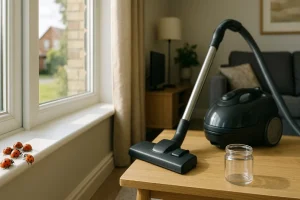If you have ever looked out at your windowsills or noticed clusters of small red, orange, or even yellow beetles inside your home, you may have wondered: why are ladybirds swarming my house? The sight can be surprising, sometimes even overwhelming, particularly when dozens or hundreds appear seemingly overnight.
While these colourful insects are often associated with good luck in folklore, their sudden appearance indoors leaves many homeowners searching for answers. The truth is that ladybirds are not invading with the intention of causing damage, but rather following a very natural instinct to survive the colder months.
Why Do Ladybirds Swarm Around Homes in Autumn?

As the days shorten and temperatures drop in late autumn, ladybirds begin preparing for hibernation. Like many insects, they cannot survive in the open air during harsh winter weather, so they search for dry, warm and sheltered places to overwinter.
Houses are particularly attractive because they provide exactly what the ladybirds are looking for: stable warmth, protection from rain, and small gaps where they can remain undisturbed until spring.
The sides of buildings that receive the most sunlight, especially south-facing walls, are the first to attract ladybirds. These warm surfaces signal to them that the structure could provide a suitable hiding place.
Homes painted in lighter colours are especially noticeable, and those with contrasting features such as dark shutters or rooflines against a pale wall are more likely to become swarming points.
Once a few ladybirds land, more tend to follow, which is why the numbers can escalate quickly.
How Do Ladybirds Enter the House?
Ladybirds are small and highly adaptable, which means they can find their way into homes through even the tiniest of openings. Cracks in brickwork, gaps under doors, damaged window seals, and vents all provide opportunities for entry.
They may also crawl in through gaps around utility pipes or wires where they meet the exterior walls.
A typical example is an older property in the countryside with exposed beams and traditional sash windows. The natural wear and tear over the years creates plenty of small entry points, making it the perfect environment for overwintering ladybirds.
In contrast, modern buildings with tightly sealed windows and doors often see far fewer of these visitors.
Why Do Ladybirds Keep Returning Year After Year?

One of the most puzzling aspects for homeowners is the repeated appearance of ladybirds in the same place every autumn. This is not a coincidence. Ladybirds use pheromones, a type of chemical scent, to communicate with one another.
When they find a safe location, they release pheromones that attract other ladybirds to the same spot. These scent markers can linger for a long time, which means that once a property has been chosen, it may continue to attract swarms in subsequent years.
Cleaning and maintaining the exterior of the home is important in breaking this cycle. Washing down walls, windows, and loft spaces with citrus-based cleaners or vinegar solutions can help remove the pheromone trails that act as signals to returning swarms.
Do Ladybirds Cause Damage When They Swarm Indoors?
Although a sudden swarm may look alarming, ladybirds do not cause structural damage to houses. They do not eat wood, fabrics, or stored food, nor do they breed indoors during the winter months. For most of their stay, they remain dormant, hidden away in corners, behind skirting boards, or inside loft spaces.
The main inconvenience they cause is cosmetic. When disturbed or crushed, ladybirds release a yellowish fluid, known as reflex blood, which has a strong odour and can stain surfaces such as paintwork, curtains, or wallpaper.
Large numbers can also create an unpleasant smell, particularly when invasive species like the Harlequin ladybird are involved.
What Can Be Done to Prevent Ladybirds From Entering?
Prevention is the most effective strategy when it comes to reducing the number of ladybirds that enter a home. By focusing on sealing gaps and removing attractants, homeowners can create a less welcoming environment for these insects.
The most reliable method is to inspect the exterior of the house carefully and seal any cracks around windows, doors, and where utility lines enter the walls.
Applying fresh caulk or repairing worn seals can make a significant difference. In lofts and attics, ventilation should be maintained, but vents can be fitted with fine mesh screens to keep insects out.
It is also helpful to clean surfaces where ladybirds tend to gather. Wiping down walls, windowsills, and entry points with citrus oil or vinegar not only removes pheromone trails but also leaves behind a scent that ladybirds dislike.
What Should Homeowners Do If Ladybirds Are Already Inside?

For those who already have ladybirds indoors, the focus should be on safe removal rather than destruction. Ladybirds are beneficial insects that feed on garden pests like aphids, and killing them eliminates their ecological value.
A vacuum cleaner can be used to collect them quickly, but the bag should be emptied outdoors straight away to prevent them from escaping back into the house.
Alternatively, they can be gently brushed into a container and released in a sheltered outdoor spot, such as near hedgerows or a bug hotel designed to provide a winter habitat.
Squashing them should be avoided, as this releases the staining yellow fluid and often attracts more ladybirds to the same location. Relocation is always the most effective and environmentally friendly solution.
When Should Pest Control Be Considered?
In most situations, ladybird swarms do not justify professional pest control. However, there are exceptions where expert assistance may be appropriate.
If hundreds of ladybirds gather across multiple rooms, leaving widespread stains and odours, homeowners may find the situation unmanageable.
In particular, invasive Harlequin ladybirds can overwhelm native populations and dominate entire areas of a property.
In such cases, ethical pest control measures may be considered to reduce numbers while protecting local biodiversity. It is important to seek advice from specialists who use environmentally responsible methods.
Comparing Ladybird Behaviour and Homeowner Response
| Ladybird Situation | Why It Happens | Best Response | Avoid This |
| Clustering on sunlit walls | Attracted by warmth and light | Seal entry points, clean surfaces | Ignoring repeated patterns |
| Gathering in lofts and attics | Seeking dry, secluded shelter | Improve ventilation, block gaps | Using insecticides indoors |
| Returning each autumn | Following pheromone scent | Wash surfaces with citrus cleaners | Allowing scent trails to remain |
| Large numbers indoors | Overwintering survival strategy | Vacuum and release outside | Squashing or killing them |
Why Are Ladybirds Beneficial Despite the Swarm?
It is easy to forget, when faced with a swarm indoors, that ladybirds are among the most helpful insects in the garden. They are natural predators of aphids, scale insects, and other pests that damage plants.
By supporting ladybird populations outdoors, homeowners can reduce the need for chemical pesticides and encourage a healthier ecosystem.
Providing bug hotels or leaving small areas of the garden wild can give ladybirds a suitable habitat for overwintering, which may reduce the temptation for them to seek shelter indoors.
Conclusion
So, why are ladybirds swarming houses in the UK? The answer lies in their natural need to survive the winter by finding dry, sheltered, and warm places to hibernate.
Attracted by sunlit walls, contrasting colours, and small gaps in buildings, they enter homes to rest until spring. While their presence can feel inconvenient, they do not cause structural harm and play a valuable role as pest controllers in gardens.
By sealing entry points, cleaning pheromone trails, and offering alternative outdoor shelters, homeowners can reduce indoor swarming while still supporting these beneficial insects.
The key is to manage them with understanding rather than alarm, recognising that their behaviour is part of the natural cycle of the changing seasons.
FAQs
Why do ladybirds appear in such large numbers in autumn?
They gather in large groups before hibernation, using warmth and pheromone signals to cluster in suitable locations.
Can ladybirds survive indoors without food?
Yes, during hibernation they do not eat and can remain dormant for several months until temperatures rise.
Why are there different colours of ladybirds in my house?
Different species vary in colour and pattern. The invasive Harlequin, for example, may appear red, orange, or even black.
Do ladybirds bite humans?
Most ladybirds do not bite, but some Harlequin ladybirds may nip if handled. It is harmless, though slightly uncomfortable.
How can I stop ladybirds coming back next year?
Removing pheromone trails with citrus cleaners and sealing cracks will help reduce repeat swarms.
Are ladybirds dangerous for pets?
No, they are not toxic or harmful to pets, although pets may find them unpleasant to taste.
What happens if I leave ladybirds inside all winter?
They will remain dormant until spring, at which point they may fly towards windows and attempt to get outside.
READ NEXT:






